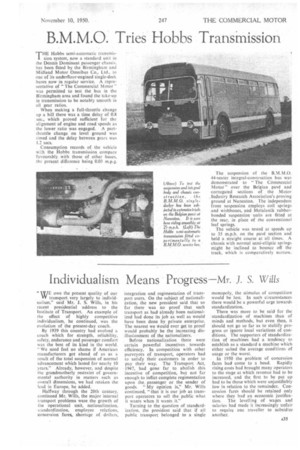B.M.M.O. Tries Hobbs Transi:nission
Page 53

If you've noticed an error in this article please click here to report it so we can fix it.
THE Hobbs semi-automatic transmis
sion system, now a standard unit in the Dennis Dominant passenger chassis, has been fitted by the Birmingham and Midland Motor Omnibus Co., Ltd., to one of its underfloor-engined Single-deck buses now in regular service. A representative of "The Commercial Motor" was permitted to test the bus in the Birmingham area and found the take-up in transmission to be notably smooth in all gear ratios.
When making a full-throttle change up a hill there was a time delay of 0.8 sec., which proved sufficient for the alignment of engine and road speeds as the lower ratio was engaged. A partthrottle change on level ground was limed and the delay between gears was 1.2 secs.
Consumption records of the vehicle with the Hobbs transmission compare favourably With those of other buses, the present difference being 0.03 m.p.g. The suspension of the B.M.M.O. 44-seater integral-construction bus was demonstrated to "The COmmercial Motor" over the Belgian pave and corrugated sections of the Motor .Indnstry Research Association's proving ground at Nuneaton. The independent front suspension employs coil springs and wishbones, and Metalastik rubberbonded suspension units are fitted at the rear, in place of the conventional leaf springs.
The vehicle was tested at speeds up to 35 m.p.h. on the pave section and held a straight course at all times. A chassis with normal semi-elliptic springs might be inclined to bounce off the track, which is comparatively narrow.




















































































